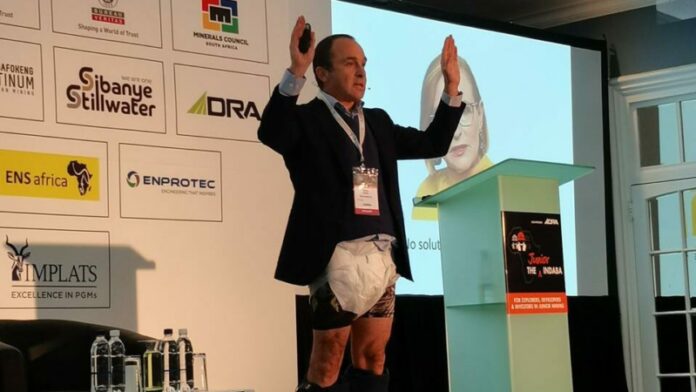
WHEN minerals lawyer Hulme Scholes took the stage at a junior mining conference earlier this month, nobody could have guessed what would happen next. After promising to demonstrate why mining firms ought to prioritise independence of Eskom above all else, Scholes shocked delegates by suddenly dropping his pants.
“Who kakked in my pants?” he asked, illustrating the point by wearing, as Americans delicately call it, a diaper. “Gwede Mantashe takes no responsibility for the energy crisis and has failed to resolve it,” said Scholes of the mineral resources & energy minister amid hoots from the audience.
As far as enlivening the last presentation of the day, the ‘graveyard shift’, went, this seemed a definitive moment. But Scholes was making the graver point that South Africa’s mining sector has all but been abandoned by a government that fails to take responsibility for even the most basic functions of the body politic. As for industry, it barely now knows how to parse its predicament. After more than five years raising flags on critical problems, it is battle weary.
Take the Minerals Council South Africa; it was once able to boycott a mines minister, Mosebenzi Zwane, Mantashe’s predecessor. Now, it seems enervated by the vacuum at the heart of the department of mineral resources & energy (DMRE). How else can you explain the bonhomie on show at the council’s AGM in May? While mining executives pretended to be friends with the minister, laughing at his amusing asides, Mantashe unblinkingly turned the finger of blame on the industry.
“In Canada, I discover CEOs promote the sector, but we don’t have that view,” said Mantashe.
He was referencing the Fraser Institute survey in which foreign investors ranked South Africa’s mining sector below those of Burkina Faso and Mali. “The report is not rating the department [of mineral resources & energy],” said Mantashe. “It is rating the industry.”
That is untrue. The report makes quite clear its participants are making assessments of national policies and implementation. These things are critical when a company makes an assessment regarding mineral exploration.
Mantashe also seems to have forgotten that in February 2019 he pledged that South Africa would control 3%-5% of total global exploration spend within five years. Today South Africa controls less than 1% of the world’s exploration purse. Having already voted with their feet, the Fraser report shows, foreign investors have forsaken South Africa because of its declining supply chains, collapsing power supply, corruption and rampant criminality.
While mining executives pretended to be friends with the minister, laughing at his amusing asides, Mantashe unblinkingly turned the finger of blame on the industry.
Some critics of the report, such as Bernard Swanepoel, chair of the Mining Indaba conferences at which Scholes spoke, says the report is taken too seriously; it is anecdotal and makes conclusions from a small sample of CEOs. “We give it too much influence,” he says. But the fact that the report collates ‘perceptions’ seems to be the point.
Says Pan African Resources CEO Cobus Loots: “Investors are especially disappointed because of what South Africa could be.”
The good news
If there’s any good news it is that the only way is up — at least, that’s how some mining executives are framing it. Several of the industry CEOs believe a little will go a long way in South Africa. That’s why some junior and mid-tier mining firms persist, hoping for better times. “You don’t have to move heaven and earth to make it [South Africa] a much better place,” says Loots, who believes power curtailment will be a thing of the past by 2025.
Pan African Resources and Sibanye-Stillwater recently signed power purchase agreements from separate wind farms under construction in the Northern Cape worth about 100MW a year.
The country even got a new junior mining listing this year when Copper360 debuted on the JSE. Its CEO, Jan Nelson, is happy that international investors shun the country’s mineral resources. “That means there’s more for me,” he says. “I’ve heard all the nonsense about South Africa and about the JSE. You can moan about it, you can moan a little bit about Eskom, but I’ve worked in Africa where [there] isn’t any power.”
I would not want to pre-empt what the Treasury decides. But when we look at the proposals we believe there [is] room for incentives. The conversation will likely result in a positive outcome
Copper360, which has Coronation as a major shareholder, is hoping to produce 8,000 tons a year of copper metal from its operations in the Northern Cape, worth about R1.6bn in annual revenue. Current output is 1,500t annually. The cost of the expansion is a mere R260m because the company is re-mining surface ore and outcrops, which doesn’t require capital-intensive shaft sinking.
It’s not true-blue exploration, but it’s probably the best type of risk capital South Africa can attract right now. In that, it’s not unlike the reopening of the Okiep and Prieska copper operations owned by Orion Minerals, run by Errol Smart. His company has struggled hard to attract capital owing to the underground nature of the company’s resources, but the fact that Orion has finance in place shows what can be achieved. The Industrial Development Corp has written some debt and equity participation in Orion, demonstrating simultaneously that while the government assists industry, it does so in silos.
Will flow-back fly?
If only the National Treasury would adopt a proposal by the Minerals Council for an incentive scheme known as flow-back shares, say industry executives.
Interestingly, DMRE director-general Jacob Mbele says flow-back shares might not be the lost cause they appear to be. “I would not want to pre-empt what the Treasury decides,” he said at the Junior Indaba. “But when we look at the proposals we believe there [is] room for incentives. The conversation will likely result in a positive outcome.”
That could be a huge moment for grassroots investment in South African mining and help soften negatives elsewhere in the sector. “I do feel the flow-through shares are a mechanism that can unlock investment,” says Kula-Verster. “We have done everything we can in terms of getting junior miners listed. But we need some form of an incentive.”
Meanwhile, the DMRE marches to its own beat.
A new system for registering and managing prospecting and mining licences and a host of other permits is needed desperately. Mantashe says that by July the DMRE will have selected a technology provider from a shortlist of five, following its second request for proposals. The first was abandoned in 2022 after the department realised it hadn’t the chops to produce a bespoke technology, as the Minerals Council warned it would fail to do.
The cadastre, as the systems are called, is two years late even by the DMRE’s own timeline. It can’t come soon enough.









